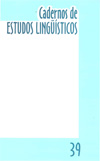Resumo
This essay makes considerations about a wider concept of language as activity and not as an artifact, although it may be in this way understood, when it is stated that anyone may appropriate language, utilize it, improve it, and little by little, modify it and, thus, adequate it to the different activities in the practices of sociocultural groups. This essay also mentions the statements of these many researchers, who rely upon the Activity Theory, inspired in Vygotsky, proposed by Y. Engeström, and summed up in the model of human activities representation. Further, the essay resorts to the Russian philosopher Mikhail M. Bakhtin (1895-1975), to whom is attributed the Theory of Dialogism, and, as a consequence, the understanding of this new conceptualization of language as not a mere human cultural artifact, but as activity in itself, as language is inherent to Being and because it is attribute and not product of Being. The formation of consciousness and learning comes about through the social relationships and constant interactions that occur everyday in activities developed in communities of practice, as studied by E. Wenger.Referências
BAKHTIN, M. M . (1995). (Yolochinov). Marxismo e filosofia da linguagem. São Paulo: Hucitec.
BANNON, L.: BODKER , S. (1999). What is activity theory? Disponível em: http://www.cudenver.edu/-mryder/itc datalactdff/html>=. Acesso em: 03 abr. 2000.
BRAIT. B. (1996). A natureza dialógica da linguagem: formas e grau de representação dessa dimensão constitutiva. In: FARACO. C. A.:
CASTRO, G. de: TEZZA, C. (Orgs.). Diálogos com Bakhtin . Curitiba: UFPR. p. 69-92.
BROWN. J. S.: DUGUID, P. (2000). The social life of information. Boston: Harvard Business School Press.
BRUCE, B. C. Technology as social practice. Disponível em <http://alexia.lis. uiuc.edu/-chip/pubs/TechasSP.shtml> Acesso em: 05 dez 2000.
HOLANDA. A. B. de. (1986). NovO dicionário Aurélio. Rio de Janeiro: Nova Fronteira.
ENGESTRÖM, I. (1999). Innovative learning in work teams: Analyzing cycles of knowledge creation in practice.
ENGESTRÖM, I. (1999). Activity theory and individual and social transformation. In: Perspectives on activity theory. Cambridge: Cambridge University Press.
ENGESTRÖM, I. (1999a). Learning by expanding: Ten years after.
FARACO, C. A. (2000). Gêneros do Discurso. Relatório / Projeto AgP (ProTem-CNPq/CEFET-PR/PUC-PR.
FARACO, C. A. (1996). O dialogismo como chave de uma antropologia filosófica. In: FARACO, C. A.; CASTRO. G. de; TEZZA, C. (Orgs.). Diálogos com Bakhtin. Curitiba: UFPR. p.113-187.
FARACO, C.A.; MERKLE, L.E. (2000). Knitting a dialogical scaffold across interaction design frameworks. (First Draft). Curitiba: CEFET-PR.
FONTINHA, R . Novo dicionário etimológico da língua portuguesa. Revisto por Dr. Joaquim Ferreira. Porto: Domingos Barreira, s.d.
FREITAS, Maria Teresa de Assunção. (1996). Bakhtin e a psicologia. In: FARACO, C.A.; CASTRO, G. de; TEZZA. C. (Orgs.). Diálogos com Bakhtin. Curitiba: UFPR. p.l65-187.
GEERTZ, C. (1978). A interpretação das culturas. Rio de Janeiro: Zahar.
HOLQUIST, M. (1981). The dialogic imagination. Texas: The University of Texas Press.
KAC, E. Holopoetry, hypertext, hyperpoetry. Disponível em: <http://www.ekac.org> Acesso em: 18 ago 2000.
KUUTI, K. (1996). A framework for HCI research. In: NARDI, B. A. (Ed.). Context and consciousness. Activity theory and human-computer interaction. Cambridge: MIT Press. p. 17-44.
LANG, A. (1997). Non-Cartesian artifacts in dwelling activities: Steps towards a semiotic ecology. In: Mind. culture, and activity: Seminal papers. from the Laboratory of Comparative Human Cognition. In: COLE, M; ENGESTRÕM, I.; VASQUEZ, O. (Ed.) Cambridge: Cambridge University Press.
MACHADO, I. (1999). Gêneros digitais e suas .fronteiras na cultura tecnológica. Palestra proferida na Semana de Tecnologia do CEFET-PR, Curitiba.
MIETTINEM, R. What is Activity Theory? Disponível em: <http://www.cudenver.edu/-mryder/itc_datalact dff.html> Acesso em: 03 abr. 2000.
MOGENSEN, P. (1992). Towards a provotyping approach in systems development. Scandinavian. Journal of' information systems, v. 4.
NARDI, B. A. What is activiry theory? Disponível em: http://www.cudenver.edu-mryder/itc_datalact_dff/html Acesso em: 03 abr. 2000.
NARDI, B. A. (1996). Activity theory and human-computer interaction. In: NARDI. B.A. (Ed.). Context and consciousness. Activity theory and human-computer interaction. Cambridge: MIT Press. p. 7-16.
NARDI, B. A. (1996a). Studying context: A comparison of activity theory, situated action models, and distributed cognition. In: NARDI, B.A. (Ed.). Context and consciousness. Activity Theory and human-computer interaction. Cambridge: MIT Press. p. 69-102.
NOTH. W. ( 1998). Panorama da Semiótica - de Platão a Peirce. São Paulo: AnnaBlume.
NOTH. W. (1999 ). A semiótica no século XX. São Paulo: AnnaBlume.
VYGOTSKY, L.S. (1999). A formação social da mente . São Paulo: Martins Fontes.
WARTOFSKY, M. W. (1979). Perception, representation, and the forms of action: Towards an historical epistemology. In: Models: representation & the scientific understanding. Dordrecht, Holland, Reidel.
WENGER. E. (1998). Communities of practice: Learning, meaning and identity. New York: Cambridge University Press.
WENGER. E. Communities of practice: Learning as a social system. Disponível em http://www.co-il.com/coil/knowledge-garden/cop/lss.shtml Acesso em: 20 set 2000.
ZINCHENKO. V. P. (1996). Developing activity theory: The zone of proximal development and beyond. In: NARDI, B.A. (Ed.). Context and conciousness. Activity theory and human-computer interaction. Cambridge: MIT Press. p. 283-324.
O periódico Cadernos de Estudos Linguísticos utiliza a licença do Creative Commons (CC), preservando assim, a integridade dos artigos em ambiente de acesso aberto.

